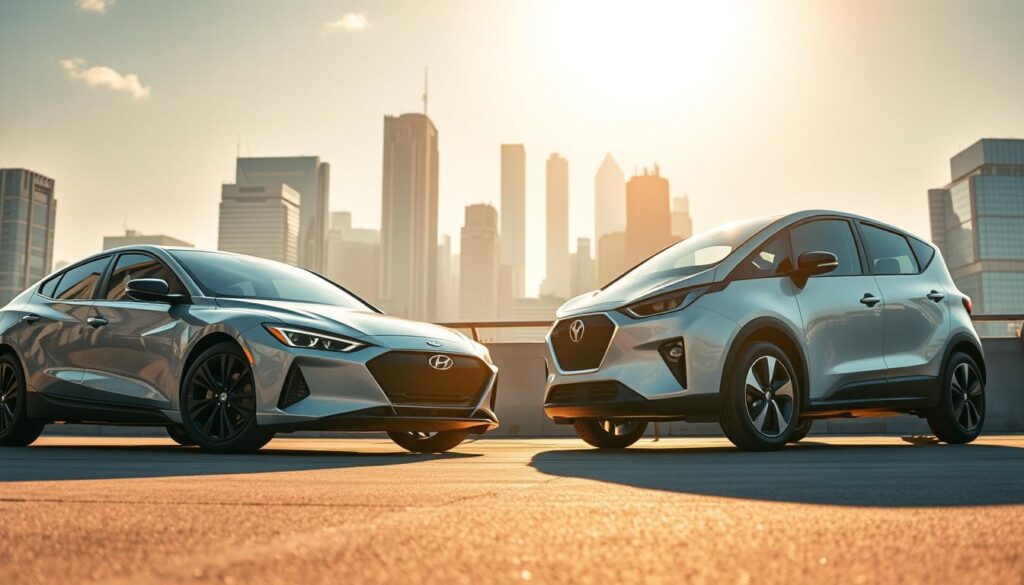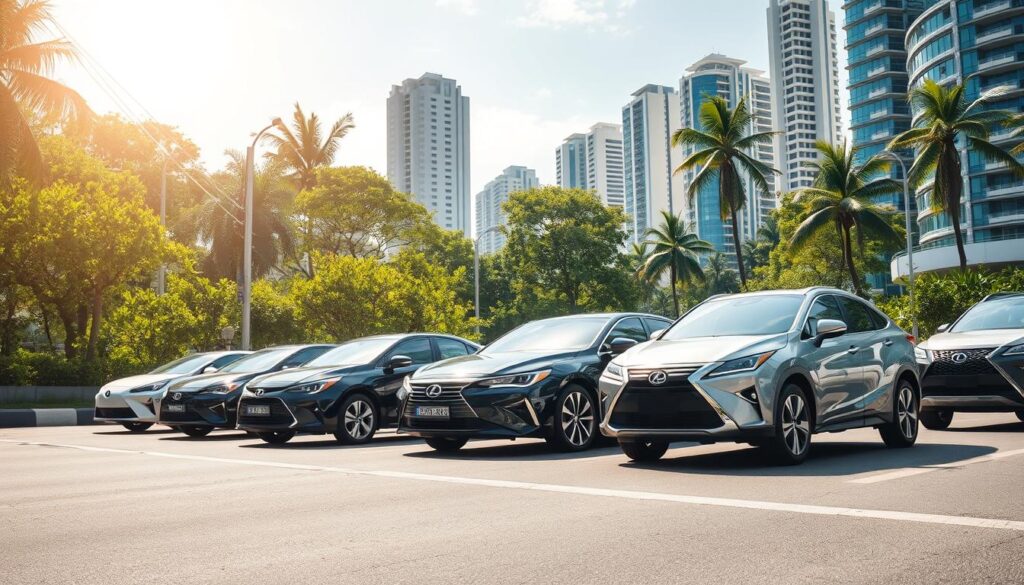Singapore is rapidly embracing eco-friendly transportation, with plans to install 60,000 EV charging points by 2030. Among the popular choices are vehicles that combine fuel efficiency with low emissions, making them ideal for urban driving.
Leading brands like Toyota and Lexus offer competitive pricing and extended warranties, such as a 10-year engine coverage. Models like the Toyota Prius deliver an impressive 32.6 km/L, while the Lexus LBX blends luxury with compact versatility.
When choosing a vehicle, consider upfront costs versus long-term savings. Traffic adaptability and emission reduction goals also play a key role in Singapore’s push for sustainable transport.
Key Takeaways
- Singapore aims to expand EV infrastructure significantly by 2030.
- Fuel-efficient models provide cost savings and lower emissions.
- Extended warranties add value to ownership.
- Urban-friendly designs enhance driving in heavy traffic.
- Government incentives support eco-conscious choices.
Why Choose a Hybrid Car in Singapore?
With rising fuel prices and urban congestion, eco-conscious drivers are turning to dual-power solutions. These vehicles cut fuel consumption by 30–50% in stop-and-go traffic, a common scenario on Singapore’s roads. The electric motor handles low-speed driving, while the petrol engine kicks in for longer stretches.
Singapore’s Vehicle Emissions Scheme (VES) rewards low-emission models with rebates, making hybrids even more affordable. Owners also benefit from lower COE costs under LTA’s eco-friendly vehicle incentives. Learn more about hybrid benefits, including service packages that match conventional car maintenance costs.
Key advantages include:
- Regenerative braking: Converts kinetic energy into electricity, boosting efficiency.
- Faster acceleration: Electric motors provide 40% more torque for quick starts.
- Lower running costs: Save an average of $130/month compared to petrol-only cars.
Models like the Lexus LBX, a Car of the Year nominee, showcase how luxury and sustainability coexist. Its compact design thrives in tight city spaces while delivering impressive fuel economy.
How Hybrid Cars Work: Technology Explained
Modern vehicles combine petrol engines with electric motors to maximize efficiency and reduce emissions. This dual-power setup adapts to driving conditions, switching seamlessly between energy sources for optimal performance.

Dual Power Sources: Engine + Electric Motor
The Toyota Hybrid System exemplifies this technology. It automatically selects power sources based on speed and load. At low speeds, the electric motor operates alone, while the petrol engine engages for highway driving.
Parallel configurations, like in the Honda Odyssey, allow both the engine and motor to work together. This boosts acceleration while maintaining fuel efficiency.
Regenerative Braking & Energy Efficiency
Key components like regenerative braking recover 15–20% of kinetic energy in city driving. This energy charges the battery, reducing waste.
- Lithium-ion batteries (e.g., Nissan Serena) offer longer lifespans than nickel-metal hydride variants.
- Thermal management systems prevent overheating, ensuring consistent performance.
Fuel Savings in Stop-and-Go Traffic
Urban driving benefits most from this technology. The Toyota Prius achieves 32.6 km/L by optimizing power splitting between its engine and motor.
“Hybrids consume 4.8L/100km compared to 7.2L/100km for conventional vehicles—a 33% reduction.”
This efficiency makes them ideal for Singapore’s traffic-heavy roads.
Hybrids vs. Electric Vehicles (EVs): Which Is Right for You?
The debate between hybrid and electric models centers on convenience, range, and infrastructure readiness. Each offers distinct advantages, but your choice depends on lifestyle and Singapore’s unique urban demands.

Power Sources and Charging Needs
Hybrids eliminate charging anxiety with their self-charging systems, while EVs rely on external power. Fast charging for EVs takes 30 minutes, but standard outlets require 8 hours—a challenge for HDB dwellers.
Plug-in hybrids, like those from Venture Cars, bridge the gap. They offer electric-only modes for short trips but retain fuel backup for longer journeys.
Driving Range and Convenience
The *Xpeng G6* EV boasts a 520km range, but hybrids like the Prius exceed 1,035km with combined fuel and electric power. Parking restrictions for EV charging cables further complicate ownership.
- EVs: Ideal for predictable routes with charging access.
- Hybrids: Suit drivers needing flexibility without infrastructure dependence.
Singapore’s Infrastructure for Hybrids and EVs
LTA plans to install 60,000 EV chargers by 2030, up from 3,600 today. Until then, hybrids benefit from existing petrol stations. HDB charging point installation costs ($3,000–$5,000) add to EV ownership hurdles.
“Hybrids provide a practical transition for drivers wary of Singapore’s evolving charging network.”
Models like the *Nissan Serena* highlight hybrid practicability, while the *Smart #1* EV appeals to tech-focused buyers. Weigh long-term value against immediate needs to make the right choice.
Top Hybrid Models in Singapore
From compact city cruisers to spacious family haulers, hybrid technology adapts to various lifestyles. These models deliver fuel efficiency without compromising on performance or comfort, making them a smart choice for Singapore’s roads.

Toyota Prius: Iconic Fuel Efficiency
The Toyota Prius remains a benchmark for efficiency, achieving an impressive 32.6 km/L. Its lightweight design and aerodynamic profile optimize energy use, while eight airbags ensure top-tier safety.
Priced at around $165,000, it’s a cost-effective option for eco-conscious drivers. The renowned brand backs it with a comprehensive warranty, covering critical components for years.
Honda Odyssey: Spacious Family Hybrid
For families, the Honda Odyssey blends versatility with practicality. Its seven-seat configuration offers ample room, while the 2.0L hybrid engine maintains a balance of power and efficiency.
Honda’s 5-year warranty underscores its reliability. Features like rear-seat entertainment and hands-free sliding doors cater to busy households.
Nissan Serena: Practicality Meets Savings
The Nissan Serena stands out with its eight-seat capacity and e-POWER technology. This system ensures smoother acceleration by eliminating gear shifts, ideal for stop-and-go traffic.
At $148,000, it’s a budget-friendly pick. The spacious cabin includes dual sliding doors, enhancing accessibility for larger groups.
Lexus LBX: Luxury Compact Hybrid
For premium appeal, the Lexus LBX combines luxury with eco-efficiency. A 12.3″ touchscreen and Mark Levinson audio system elevate the driving experience, while ambient lighting adds sophistication.
Priced at $215,000, it includes a 10-year battery warranty. Its compact size makes it agile in urban settings without sacrificing comfort.
| Model | Price (SGD) | Key Feature |
|---|---|---|
| Toyota Prius | $165,000 | 32.6 km/L fuel economy |
| Honda Odyssey | $180,000 | 7-seat family flexibility |
| Nissan Serena | $148,000 | e-POWER acceleration |
| Lexus LBX | $215,000 | 10-year battery coverage |
Key Considerations When Buying a Hybrid
Ownership costs extend beyond the showroom price—maintenance and resale play critical roles. To maximize value, compare upfront expenses against long-term benefits like fuel efficiency and warranty coverage. Here’s what savvy buyers prioritize.

Upfront Cost vs. Long-Term Savings
Hybrids often carry a $20,000 premium over petrol models. However, fuel savings of $130/month can recoup this in 4 years. Parallel importers may offer 15–20% lower prices, but authorized dealers provide better service networks.
Fuel Efficiency and Traffic Adaptability
Stop-and-go traffic boosts regenerative braking efficiency. Models like the Toyota Prius achieve 32.6 km/L, ideal for city driving. Compact designs optimize cabin space without sacrificing performance.
Maintenance and Warranty Coverage
Battery replacement costs $4,000–$8,000, but warranties like Venture Cars’ 5-year/130,000km plan mitigate risks. Premium quality components in Lexus hybrids reduce long-term repair needs.
Resale Value and Market Trends
Hybrids retain 55–60% value after 5 years, outperforming petrol cars (45%). 2024 trends show hybrids outselling EVs 3:1. Always verify LTA-approved modifications to preserve resale potential.
- ROI Calculation: Factor in fuel savings, tax rebates, and maintenance costs.
- Warranty Terms: Prioritize coverage for batteries and power electronics.
- Resale Prep: Keep service records and avoid unauthorized upgrades.
Conclusion
Choosing the right vehicle involves balancing efficiency, comfort, and budget. Models like the Toyota Prius excel in fuel savings, while the Lexus LBX offers luxury in a compact frame. Families may prefer the spacious Nissan Serena for its versatility.
With rising COE prices, dual-power options provide long-term value. Dealers like Venture Cars enhance ownership with perks such as 10-year warranties and flexible payment plans. The market is projected to grow by 15% annually, reflecting increasing demand.
Ready to experience these benefits? Test drive your top choices today to find the perfect fit for your lifestyle.

